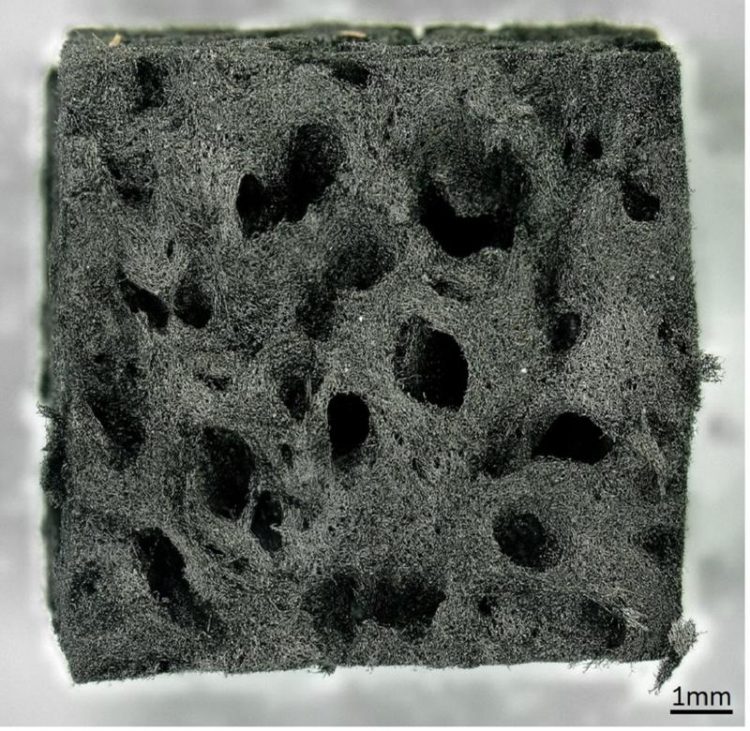TU Bergakademie Freiberg develops unique material from marine bath sponge skeleton

Der neuartige Kohlenstoffschwamm. Foto: TU Bergakademie Freiberg
The so-called “graphite” has unique structural, mechanical and thermal properties and could serve as a centimetre-thin catalyst for industry in the future. The model for the new material is the carbonized 3D skeleton of a marine bath sponge. This consists of collagen-containing spongin and is particularly stable and heat-resistant due to its multi-layer nanofibers.
In various experiments, scientists led by Prof. Hermann Ehrlich of the Technical University Bergakademie Freiberg have carbonized the spongin scaffolds at temperatures of up to 1200 degrees Celsius.
The resulting carbon sponge resembles the shape and unique microarchitecture of the original spongin scaffold and is so stable that it can be cut into any shape with a metal saw. Coated with a metal layer, it also becomes a unique hybrid material with excellent catalytic performance.
“We have found a new way to use familiar bath sponges. Instead of using them only for cosmetics, we can now also use them for modern technologies,” says Prof. Ehrlich happily. Together with his team, he is working on initial proposals for the production of the biomimetically inspired catalyst for industry.
For the past two years, the 29-member team has been researching the structure of the naschwachsenden marine sponges, developed by nature and in existence for 600 million years, in order to develop biomimetic models as alternatives to plastic frameworks for modern materials science. They are supported by the German Research Foundation (DFG) and the State Ministry of Science and the Arts.
The research work was published before October 4 in the renowned journal “Science Advances”: https://advances.sciencemag.org/content/5/10/eaax2805.full.
Extreme Biomimetics is a new scientific special field at the TU Bergakademie Freiberg. It deals with the investigation of natural and artificial phenomena for the development of novel bioinspired 3D composites. The scientists use renewable, naturally occurring and non-toxic organic scaffolds on a centimetre to metre scale.
Prof. Dr. Hermann Ehrlich, Phone: +49 3731 39 2867
https://advances.sciencemag.org/content/5/10/eaax2805.full
https://tu-freiberg.de/esm/institut/institutsleitung/biomineralogie-und-extreme-…
Media Contact
All latest news from the category: Materials Sciences
Materials management deals with the research, development, manufacturing and processing of raw and industrial materials. Key aspects here are biological and medical issues, which play an increasingly important role in this field.
innovations-report offers in-depth articles related to the development and application of materials and the structure and properties of new materials.
Newest articles

NASA: Mystery of life’s handedness deepens
The mystery of why life uses molecules with specific orientations has deepened with a NASA-funded discovery that RNA — a key molecule thought to have potentially held the instructions for…

What are the effects of historic lithium mining on water quality?
Study reveals low levels of common contaminants but high levels of other elements in waters associated with an abandoned lithium mine. Lithium ore and mining waste from a historic lithium…

Quantum-inspired design boosts efficiency of heat-to-electricity conversion
Rice engineers take unconventional route to improving thermophotovoltaic systems. Researchers at Rice University have found a new way to improve a key element of thermophotovoltaic (TPV) systems, which convert heat…



